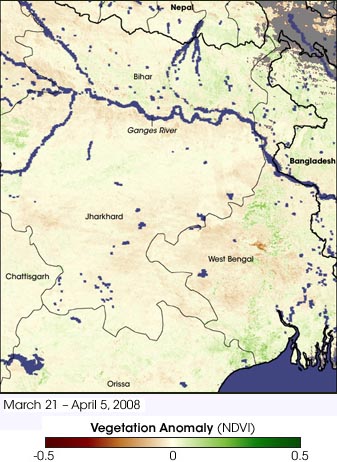“Bihar would have a bumper Rabi crop this year.” This prediction came from the NASA (National Aeronautics and Space Administration)MODIS ( Moderate Resolution Imaging Spectroradiometer) images released early this week. This is much in contrast to the Bihar Economic Survey predicting a sharp fall in the food grains production in the state this year.
 With the harvest in the spring of 2008, the country’s
rice and corn production were set to reach record
levels, said the US Department of Agriculture’s
Foreign Agricultural Service. This image shows vegetation conditions as observed by the MODIS on NASAâ's Terra satellite between March 21 and April 5, 2008, compared to average conditions observed during the same period from 2000 through 2007. Spots of green
faint colour show the Indian states of West Bengal and
Bihar, two of the areas where rice and corn crops were
thriving. West Bengal was wrapping up its second crop
of rice (the rabi, or spring-harvested rice) when the
data used to make this image were acquired. The Bihar image can also be interpreted for the cultivation of major rabi crops like wheat and pulses. A strip of
green runs from the Bay of Bengal in the south to the
gray, cloud-covered area in the north, indicating that
plants were lusher than average. The light brown areas
elsewhere in the state point to regions where plants
were not growing as much as they normally do at the
end of March. The bumper crop of rice followed in the
wake of above-average monsoon rains during the
June-September monsoon. At the end of the winter
harvest, India had produced 81.5 million tons of rice,
a million tons more than the 2006-2007 harvest, and by
the end of April, production was expected to reach 94
million tons, said the Foreign Agricultural Service.
To the west of West Bengal, Bihar was preparing for a
record crop of corn, known as maize here.
With the harvest in the spring of 2008, the country’s
rice and corn production were set to reach record
levels, said the US Department of Agriculture’s
Foreign Agricultural Service. This image shows vegetation conditions as observed by the MODIS on NASAâ's Terra satellite between March 21 and April 5, 2008, compared to average conditions observed during the same period from 2000 through 2007. Spots of green
faint colour show the Indian states of West Bengal and
Bihar, two of the areas where rice and corn crops were
thriving. West Bengal was wrapping up its second crop
of rice (the rabi, or spring-harvested rice) when the
data used to make this image were acquired. The Bihar image can also be interpreted for the cultivation of major rabi crops like wheat and pulses. A strip of
green runs from the Bay of Bengal in the south to the
gray, cloud-covered area in the north, indicating that
plants were lusher than average. The light brown areas
elsewhere in the state point to regions where plants
were not growing as much as they normally do at the
end of March. The bumper crop of rice followed in the
wake of above-average monsoon rains during the
June-September monsoon. At the end of the winter
harvest, India had produced 81.5 million tons of rice,
a million tons more than the 2006-2007 harvest, and by
the end of April, production was expected to reach 94
million tons, said the Foreign Agricultural Service.
To the west of West Bengal, Bihar was preparing for a
record crop of corn, known as maize here.
Rivers running from the Himalaya Mountains into the
Ganges bring water and fertile soil to the
agricultural state. In Bihar and other corn-growing
areas throughout India, good weather conditions
sustained a healthy crop that the USDA predicted would
yield a record 16.8 million tons of corn. The section
of Bihar that is north of the Ganges River is flushed
green in this image, a reflection of the good growing
conditions, view a high-resolution image.
Whatever be the NASA’s projection of foodgrains, the
figure of the Economic Survey of 2007-08 says “While rice production has fallen by 24.4 percent in
comparison to the previous year's. The production of wheat
has fallen by about 19 percent. It is maize (known as
corn in the United States), which has suffered the
most significant fall, with its production falling by
almost 47 percent over the previous year.”
Thus the overall fall in the agriculture production
was 26.04 per cent in the year 2007-08. There are
three crops of maize in Bihar, but it is essentially a
Kharif crop and harvested in the early winter.
Reports from different parts of Bihar also confirm
that the state has bumper Rabi crop notwithstanding
early April rain. The NASA image also suggests that it
is now easily possible to detect the food grains
production anywhere in the world.